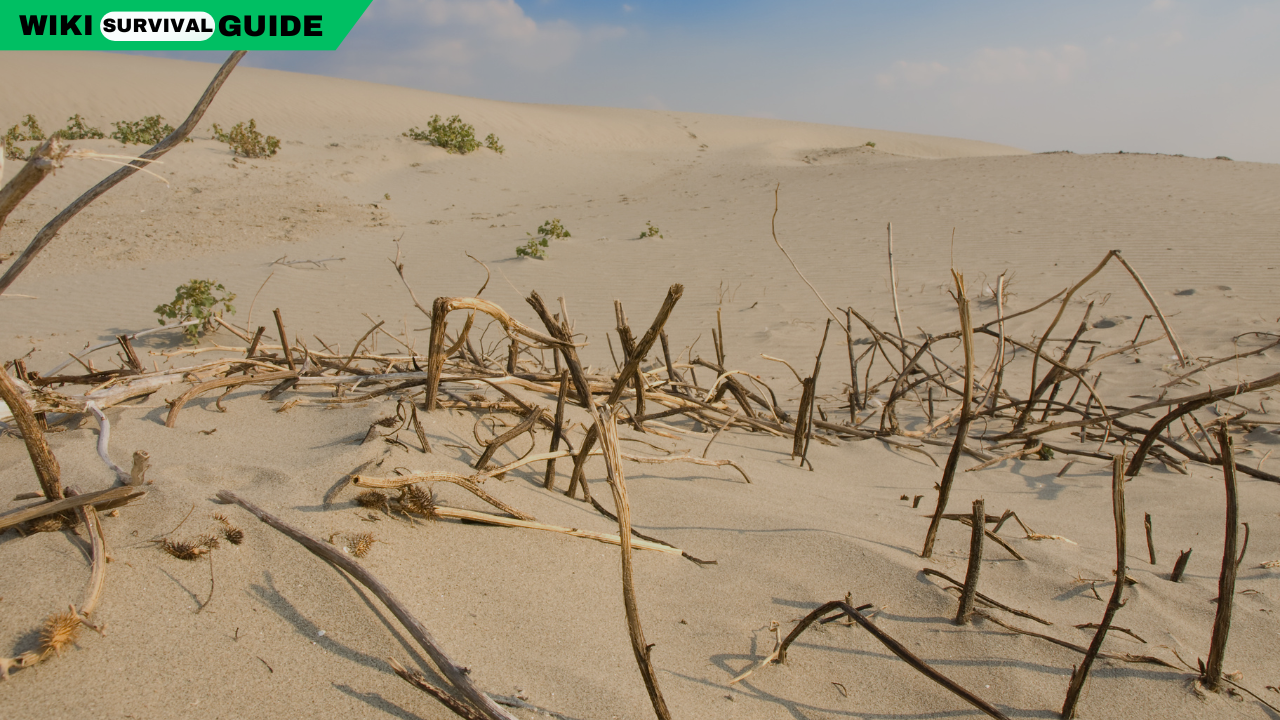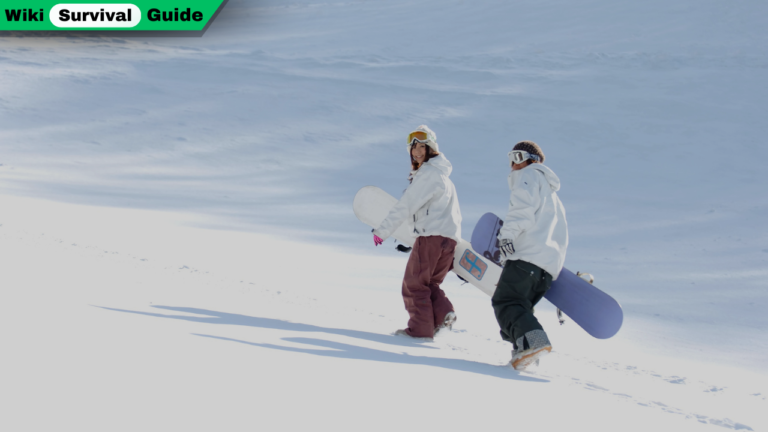Master the Essential Desert Survival Guide: Tips to Thrive in Harsh Conditions at WikiSurvivalGuide.com. From finding water to building shelters, these proven techniques ensure you stay safe and resilient in brutal desert environments in 2025.
Why Desert Survival Skills Matter
Deserts, with less than 10 inches of annual rainfall, are among Earth’s harshest environments, featuring scorching days (100°F+) and freezing nights (below 32°F). In 2023, over 1,200 heat-related deaths occurred in the U.S., many in deserts like Arizona’s Sonoran. Proper skills prevent dehydration, heatstroke, and disorientation. Check More Here:- 10 Essential Survival Tips for Highly Sensitive People
Unique Challenges of Deserts
Extreme temperature swings, scarce water, and sparse vegetation test even seasoned adventurers. Dehydration can kill within 3 days, while navigation errors in vast, featureless landscapes lead to 30% of desert rescues, per the National Park Service. Venomous wildlife (e.g., rattlesnakes) adds further risk.
Benefits of Preparation
A well-planned survival strategy cuts dehydration risk by 80%, per survival experts. Carrying essentials like water (1 gallon/day), a map, and a signal mirror costs ~$50–$100 and boosts survival odds. Skills like solar stills or fire-starting require minimal gear, empowering self-reliance.
Essential Gear and Mindset
Pack a survival kit: water, knife, fire starter, blanket, compass, and first-aid supplies. Lightweight, loose clothing and a wide-brimmed hat reduce sunburn. Mental resilience—staying calm and prioritizing shelter, water, and signaling—is critical, as panic wastes energy and fluids.
Getting Started
Plan your route, share it with others, and check weather forecasts to avoid flash floods (July–September). Move at dawn or dusk to conserve sweat, saving ~3 liters of water daily. Visit WikiSurvivalGuide.com for trip planning templates and survival kit checklists.

Survival Tips Overview Table
| Tip | Time to Implement | Difficulty | Best For |
|---|---|---|---|
| Conserve Water | Ongoing | Easy | Preventing dehydration |
| Find Natural Water | 1–2 hr | Medium | Emergency hydration |
| Build a Solar Still | 1 hr | Medium | Water collection |
| Construct a Shelter | 30–60 min | Easy | Sun and cold protection |
| Start a Fire | 15–30 min | Medium | Warmth, signaling |
| Navigate with Map/Compass | Ongoing | Medium | Avoiding disorientation |
| Signal for Rescue | 10–30 min | Easy | Attracting help |
| Forage Edible Plants | 1–2 hr | Hard | Emergency nutrition |
| Avoid Wildlife Dangers | Ongoing | Easy | Preventing bites/stings |
| Manage Mental Resilience | Ongoing | Medium | Decision-making under stress |
10 Essential Desert Survival Guide: Tips to Thrive in Harsh Conditions
1. Conserve Water
Description: Minimize water loss through sweat and respiration to extend survival time.
Benefits: Saves ~3 liters/day; delays dehydration. Costs $0.
Process: Rest in shade during peak heat (10 AM–4 PM, 5–10 min to find). Wear loose, light clothing (e.g., cotton long sleeves, $20). Sip water (1 gallon/day) instead of gulping. Avoid exertion; travel at dawn/dusk (1–2 hr windows).
Applications: All desert scenarios, especially low-water situations.
Tip: Breathe through your nose to reduce moisture loss.
2. Find Natural Water Sources
Description: Locate water using environmental clues like vegetation or topography.
Benefits: Provides 1–2 liters in emergencies; critical for survival. Costs $0–$10 (map).
Process: Scout for green plants, animal tracks, or birds at dawn/dusk (30–60 min). Check low areas like canyons or dry riverbeds (30 min). Dig 1–2 ft in depressions for groundwater (15 min). Purify with tablets ($5, 30 min) or boiling (10 min).
Applications: Remote areas with sparse water.
Tip: Follow bees or pigeons, as they fly to water sources.
3. Build a Solar Still
Description: Extract water from soil or plants using a plastic sheet and sunlight.
Benefits: Yields ~0.5 liters/day; works in arid zones. Costs $5–$10 (plastic).
Process: Dig a 2-ft-wide, 1-ft-deep hole (20 min). Place a cup in the center. Cover with a clear plastic sheet, sealing edges with dirt. Place a pebble in the center to create a drip point (10 min). Collect water after 4–6 hr.
Applications: Areas with moist soil or cacti.
Tip: Add green plants inside the hole to increase yield.
4. Construct a Shelter
Description: Create shade to protect from sun and insulation for cold nights.
Benefits: Reduces heatstroke risk by 50%; retains warmth. Costs $10–$20 (blanket).
Process: Find natural shade (e.g., rock overhang, 5 min) or string a tarp/blanket between rocks or cacti (15 min). Layer brush on top for insulation (10 min). Dig a shallow trench (6–12 inches) for cooler air (15 min).
Applications: Daytime rest, nighttime warmth.
Tip: Face shelter opening away from wind to avoid sand.
5. Start a Fire
Description: Use fire for warmth, cooking, or signaling rescuers.
Benefits: Provides heat (32°F+ boost); attracts attention. Costs $5–$15 (flint).
Process: Gather dry twigs, bark, or dung (10 min). Create a fire pit with rocks (5 min). Use a flint striker or matches to ignite tinder (5 min). Add fuel gradually (ongoing). Build three fires in a triangle for distress signaling (15 min).
Applications: Cold nights, rescue scenarios.
Tip: Use green branches for daytime smoke signals.
6. Navigate with Map and Compass
Description: Use a map and compass to avoid getting lost in featureless terrain.
Benefits: Prevents 30% of rescue cases; ensures safe travel. Costs $10–$30.
Process: Study map for landmarks before travel (10 min). Align compass to magnetic north (2 min). Track direction using sun (east at sunrise, west at sunset) or stars (5 min). Mark path with rocks every 100 ft (ongoing).
Applications: Long treks, unfamiliar deserts.
Tip: Practice compass use at home to build confidence.
7. Signal for Rescue
Description: Attract rescuers using mirrors, fires, or ground markers.
Benefits: Increases rescue odds by 70%; fast response. Costs $5–$15 (mirror).
Process: Flash a signal mirror at aircraft or distant points (5 min). Build three signal fires in a triangle (15 min). Arrange rocks in “SOS” or arrow shapes (20 min). Use bright clothing as flags (5 min).
Applications: Stranded scenarios, remote areas.
Applications: Stranded scenarios, remote areas.
Tip: Signal in open areas for maximum visibility.
8. Forage Edible Plants
Description: Identify safe plants like prickly pear for emergency nutrition.
Benefits: Provides 100–200 calories; prevents starvation. Costs $0–$10 (guidebook).
Process: Learn edible plants (e.g., prickly pear fruit, 30 min study). Scout for cacti or mesquite pods (30–60 min). Peel prickly pear pads or fruit with a knife (10 min). Cook pads over fire (10 min). Avoid unknown plants.
Applications: Multi-day survival without food.
Tip: Carry a pocket plant guide for identification.
9. Avoid Wildlife Dangers
Description: Minimize encounters with snakes, scorpions, or bees.
Benefits: Reduces bite/sting risk by 90%; ensures safety. Costs $0–$20 (first-aid).
Process: Wear high boots and long pants (5 min prep). Check shoes and bedding for scorpions (2 min daily). Avoid beehives; run and cover neck if attacked (immediate). Keep limbs cold if bitten and seek help (1–2 hr). Carry Benadryl ($5).
Applications: Hiking, camping in wildlife zones.
Tip: Freeze if you hear a rattlesnake to locate it.
10. Manage Mental Resilience
Description: Stay calm and focused to make sound survival decisions.
Benefits: Cuts panic-related errors by 60%; boosts endurance. Costs $0.
Process: Take deep breaths to calm nerves (1 min). Prioritize tasks: shelter, water, signaling (5 min). Set small goals (e.g., build shelter by noon, 10 min planning). Reflect on loved ones for motivation (5 min daily).
Applications: High-stress, isolated scenarios.
Tip: Recite a mantra to maintain focus.
Desert Hazards Table
| Hazard | Risk Level | Prevention Strategy |
|---|---|---|
| Dehydration | High | Carry 1 gallon water/day, sip regularly |
| Heatstroke | High | Rest in shade, wear loose clothing |
| Hypothermia | Medium | Use blanket, build fire at night |
| Flash Floods | Medium | Avoid canyons in July–September |
| Venomous Wildlife | Medium | Wear boots, check bedding, carry Benadryl |
Tips for Desert Survival Success
- Plan Ahead: Share GPS coordinates and return dates with family (10 min).
- Pack Smart: Include 2 water bladders, purification tablets, and a Mylar blanket ($50).
- Stay Nocturnal: Move at night to save water and energy (1–2 hr planning).
- Learn Local Flora: Study edible plants like prickly pear before travel (1 hr).
- Practice Skills: Test fire-starting or compass use at home (30 min).
Conclusion
The Essential Desert Survival Guide: Tips to Thrive in Harsh Conditions equips you to conquer arid landscapes with confidence. From conserving water to signaling for help, these techniques ensure safety and resilience in 2025. Visit WikiSurvivalGuide.com for more survival resources and share your tips on Facebook with #WikiSurvivalGuide!
Frequently Asked Questions
What’s the most critical desert survival tip?
Conserving water is key, as dehydration can kill in 3 days. Carry 1 gallon/day, sip slowly, and rest in shade to save ~3 liters daily.
How do I find water in the desert?
Look for green vegetation, animal tracks, or low areas like canyons. Dig for groundwater or build a solar still for ~0.5 liters/day.
What should I pack for desert survival?
Include water (1 gallon/day), a knife, fire starter, Mylar blanket, compass, map, and first-aid kit. Total cost: ~$50–$100.
How do I stay safe from desert wildlife?
Wear boots, check bedding for scorpions, and avoid beehives. Carry Benadryl and keep bitten limbs cold while seeking help.
Where can I learn more desert survival skills?
Visit WikiSurvivalGuide.com for guides on water sourcing, shelter building, navigation, and emergency signaling techniques.




Leave a Comment